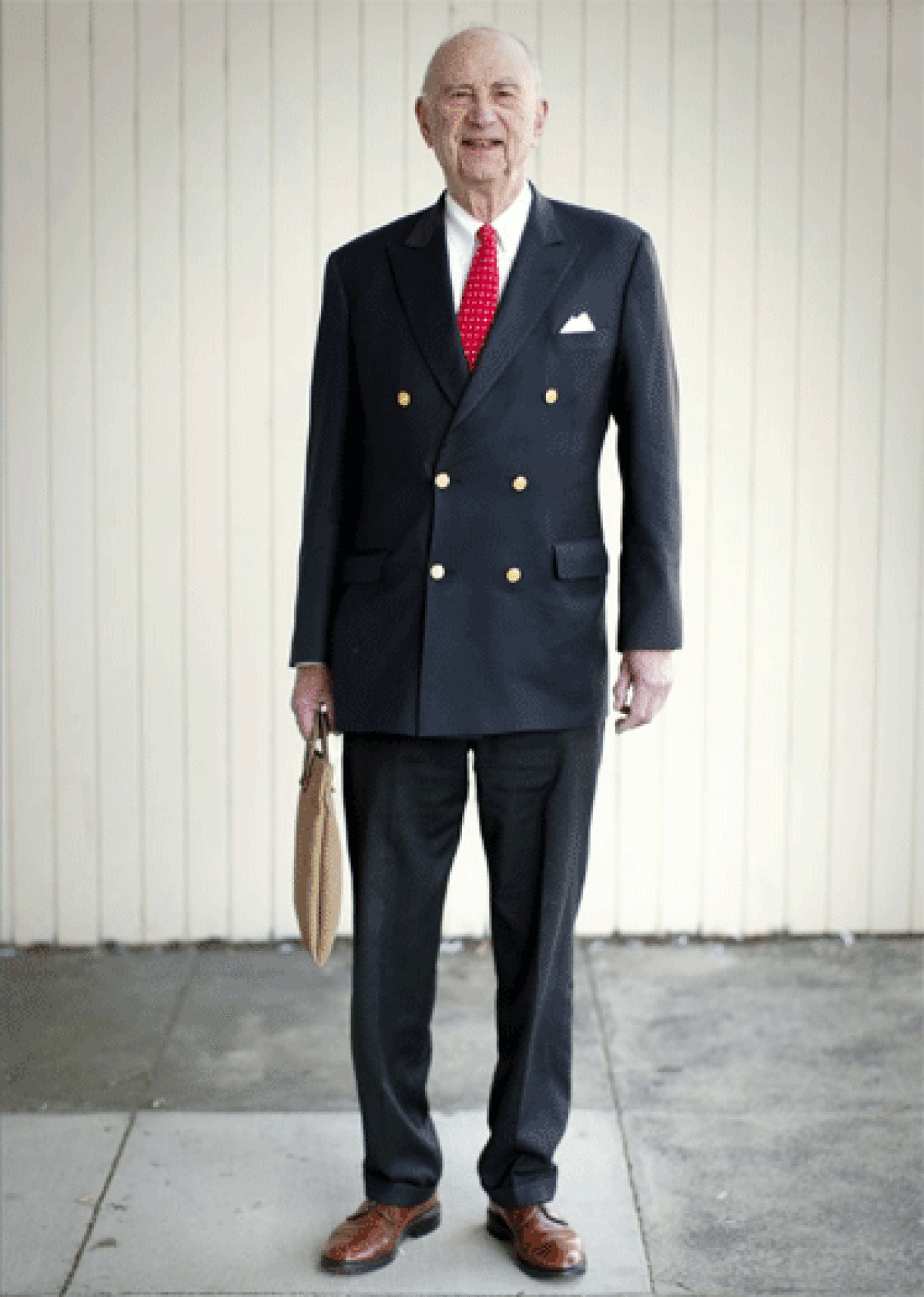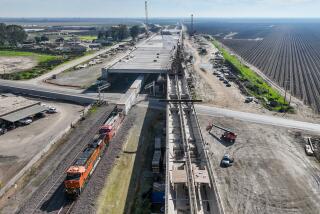Quentin Kopp, no longer on board this bullet train

There’s a short piece of Bay Area freeway, Interstate 380, named for Quentin Kopp, which is ironic considering that he’s beaten the drum for public transit — specifically bullet trains — for years. But then again, he’s always been a contrarian, as a Superior Court judge, a San Francisco supervisor and a state senator. He also headed the California High-Speed Rail Authority. The man nicknamed the “Great Dissenter” is dissenting now over the course of his beloved bullet train, created on paper in 2008 with a bond measure, Proposition 1A. Its prospects have been slowed considerably by lawsuits, the latest from the state itself, a preemptive bring-it-on legal action called High-Speed Rail Authority vs. All Persons Interested. Kopp is among the very interested, and the not very happy.
Oscar Wilde said that each man kills the thing he loves. You love high-speed rail. Why do you want to kill it now?
I want to kill this iteration of it because it betrays the representations to the voters in November 2008.
Most epiphanies in France have to do with wine or cheese. Yours had to do with high-speed rail, in 1982.
My son had been on an exchange program. He said, “There’s this new train from Lyon to Paris,” and I said, “Let’s try it.” That was the epiphany.
Do you still think California needs a bullet train?
Yes. It will attract riders otherwise circumscribed by vehicular congestion and the inability of airports to host increasing number of flights. High-speed rail fares can and will beat airplane fares.
Will California’s ever get built?
The Kings County lawsuit [alleging that parts of the current plan violate Proposition 1A’s provisions] should stop the spending of any money on the violative parts of the plan and force the High-Speed Rail Authority to restore the 2008 plan.
There are objections all along the route, some from areas because they’re included, some because they’re not.
There were problems coming over the Grapevine, with the Tejon Ranch Co. Palmdale complained because it wasn’t going through Palmdale. If I were able to effectuate it now, I’d build L.A. to San Diego first. The politics stem from the route. You expect that in a public project.
There’s also a ballooning cost estimate of $68 billion. Gov. Jerry Brown just went to China, looking for the Chinese to invest. He said they could “make a lot of money in California.”
That would be good! I think somewhere between 20% and 25% of the total cost was contemplated as coming from private sources.
Another way to persuade the Chinese, more ambitious theoretically, would be to turn the project over to them. But you’d have to change the provisions of Proposition 1A, and that would be a political problem — the notion of turning it over to private investors, Chinese investors.
We never contemplated private investment until about 70% or 75% of the first phase was built or at least started. Private investors aren’t going to come in until they see that it’s going to happen. It is a long shot to tell California that Brown might be able to dicker with the Chinese to come into this project.
Does Proposition 1A allow for private ownership?
It does not. It allows for operation by a private entity — in fact, it’s premised upon operation by a private entity. No state agency will operate the train.
What’s wrong with the current iteration of the plan? How did it go off the rails?
The cunning progenitors of this plan have expropriated bond money to improve commuter rail [for use in the high-speed system].
[But] high-speed rail can only operate on dedicated track, separated not shared. [Legislators] don’t have the guts to stand up and say to their constituents, “We’re one state and the voters in this one state agreed to it.”
[The current plan] was adopted under political pressure, toadying to the wealthy people of Atherton, Menlo Park, Palo Alto and Burlingame, best characterized as NIMBYs, who fear losing their palatial properties and fear noise, which is ironic because high-speed rail trains make less noise than diesel.
Their plan would electrify Caltrain [the San Francisco Peninsula commuter system] to operate at a speed up to 125 miles per hour. That is the reason for the raid on Proposition 1A [bond funds]. And if you give money to a Northern California commuter rail, politically you have to match it for Southern California.
Those factors led to the dismembering of high-speed rail, the sorry spectacle of the first alleged usable segment, which is not usable, 130 miles from Merced to Bakersfield, which will now be built as conventional rail!
Why can’t commuter and high-speed rail share tracks?
To operate profitably, or without any taxpayer subsidy, you must operate, at peak hours, about 10 high-speed trains per hour. If you share the tracks with the commuter system, you can’t do that. HSR wouldn’t be able to run more than two trains per hour, [although] the HSR authority claims it might be able to run four per hour.
The project has not been subject to financial corruption in the sense of individuals lining their pockets. It has been subject to decision-making corruption, political winds.
One example, $1.1 million had been spent examining the option of sharing track L.A. to Anaheim. It was discarded. You can’t share tracks! I’ll be a son of a gun, in 2010, before I left the HSR authority, [other members] wanted to reinsert the sharing of track with Amtrak and Burlington Northern, which runs freight at night. I said what are you talking about? It’s already been studied! We spent $1.1 million! The vote was seven to one and I was the one. So I saw what was coming.
You once said 90% of legislation is totally insignificant. Why can’t California seem to get big things done?
One reason is term limits. It has increased the looking-over-your-shoulder of legislators, which leads to a diminution of ability to effectuate major improvements and leads to all this chicken-feed legislation. And local and state governments all have financial problems resulting from health and pension benefits that aren’t sustainable.
You were the state Senate’s only independent in a century.
I’m fiscally responsible and conservative, but I’m no friend of Wall Street. I abhor it. My creed is, bring back Glass-Steagall regulations and you’ll take care of those banks.
And you were renowned for your grand and grammatically correct oratorical flourishes, which you clearly enjoy.
I do. I abhor the phrase “you know.”
Is some of your grandiloquence strictly for effect?
Maybe a little is for effect. I’ll place it at about 25%.
When you ran for mayor of San Francisco in 1979, Dianne Feinstein won. Would San Francisco be different today if you’d been elected?
I would have had a difficult time because the population was changing faster than I would have been able to adapt to. It became overwhelmingly liberal. The word now is “progressive,” which I think is an evasion. I would have liked to have given it a try.
Any nice words from a San Franciscan for L.A.?
I love Los Angeles. Los Angeles was the first city I saw in California, in the summer of 1940. An aunt and uncle had left Syracuse during the Depression. My aunt Frances was the niece of a founder of 20th Century Fox, and they transformed my uncle from a pharmacist into a theater manager. [But] the Air Force stationed me in Sacramento, which brought me into San Francisco every weekend.
Do you think you’ll ever get to ride a California bullet train?
I’m 84. The odds are I won’t. I’ll have to go back to Europe.
Follow Patt Morrison on Twitter @pattmlatimes
This interview was edited and excerpted from a taped transcript. An archive of Morrison’s interviews can be found at latimes.com/pattasks.







